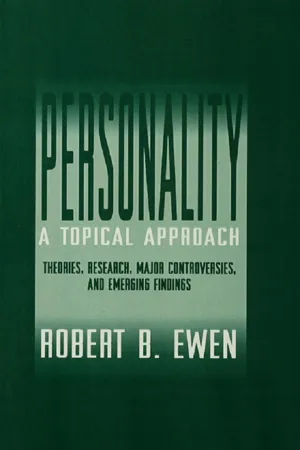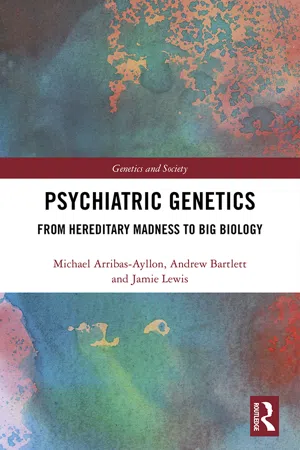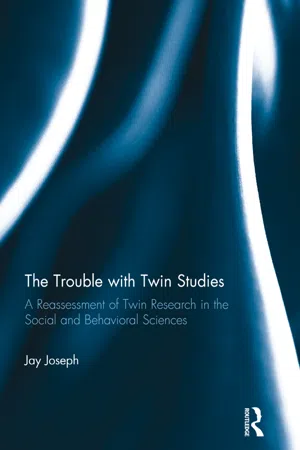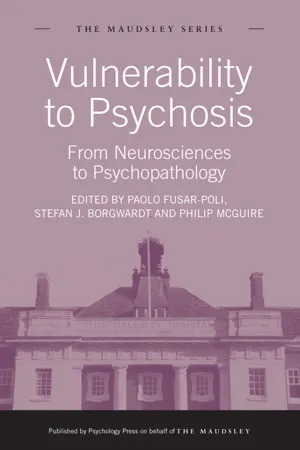Psychology
Twin Studies Gottesman
Twin studies conducted by Gottesman have been instrumental in understanding the role of genetics in psychological traits and disorders. By comparing the similarities between identical and fraternal twins, these studies have provided evidence for the heritability of various psychological characteristics, such as intelligence, personality, and mental illnesses. Gottesman's work has significantly contributed to the nature-nurture debate in psychology.
Written by Perlego with AI-assistance
Related key terms
8 Key excerpts on "Twin Studies Gottesman"
- eBook - ePub
Personality: A Topical Approach
Theories, Research, Major Controversies, and Emerging Findings
- Robert B. Ewen(Author)
- 2013(Publication Date)
- Psychology Press(Publisher)
Failure. If you fail at a particular task-you cannot learn algebra, or you are too idealistic to succeed in politics-should you attribute your failure to “being born that way?” If personality is determined primarily by nurture, such arguments are rationalizations, and you should try harder. But if heredity is the major determinant of personality, trying harder may be the worst thing you can do, for you may be forcing yourself to engage in an activity for which you are fundamentally unsuited.Twin StudiesOne method that has been used to study the nature-nurture issue is the twin study. Monozygotic twins (identical twins) come from the same fertilized egg, are always of the same sex, are very much alike physically, and have identical genes. Dizygotic twins (fraternal twins) come from different eggs, are no more alike genetically than two siblings born at different times, and may be of different sexes. The researcher measures how similar monozygotic twins are on various personality characteristics (e.g., traits such as aggressiveness, assertiveness, and empathy), and compares this to how similar dizygotic twins are on these characteristics.Suppose that monozygotic twins more closely resemble each other than do dizygotic twins. What might this mean? It would seem that twins, whether they are monozygotic or dizygotic, experience the same environment: Their parents feed them, change their diapers, toilet-train them, and so forth at about the same time and in much the same way. If this is true, only heredity can explain why the monozygotic twins are more similar. That is, if monozygotic twins are more alike on certain traits than are dizygotic twins, this would suggest that heredity plays a greater role in determining these characteristics than does the environment.As is often the case in personality research, this method suffers from significant methodological problems. Most importantly, it appears that the environments of monozygotic twins are more alike than the environments of dizygotic twins. Monozygotic twins are more likely to be treated in similar ways because of their physical resemblance, and because such twins are often dressed in identical clothes. It is easier to treat dizygotic twins differently because they differ considerably in appearance and usually wear different clothing. So the personalities of monozygotic twins are more similar than the personalities of dizygotic twins not only because their genes are more alike, but also because their environments are more alike. Yet the researcher, believing that environmental effects have been held constant, will attribute all of this greater similarity to genetic factors. Therefore, such studies are likely to overestimate - eBook - ePub
Identical Twins
The Social Construction and Performance of Identity in Culture and Society
- Mvikeli Ncube(Author)
- 2018(Publication Date)
- Routledge(Publisher)
2 Traditional psychological research on twinsThis chapter offers a critique of traditional psychological studies of twins and anticipated key issues. It highlights the limitations of mainstream psychological research, for example in the way in which twins are used as objects to explore other questions rather than consider their own experiences. Assumptions are made about the nature of twins, which are then confirmed in the way studies are carried out and reinforce the conventional stereotyped image of them as individuals locked in a relationship with another individual. This chapter argues that twin research in psychology has invariably treated the subjects of studies as objects and as vehicles to promote social inequalities. Mainstream twin studies reinforce conventional stereotypes of a supposed ‘twin similarity’, thereby undermining personal uniqueness and authentic individual differences. Findings from these studies imply that this similarity is ‘natural’ for identical twins and so differences are ‘artificial’. The studies make assumptions about heredity, and seem to over-generalise claims based on ostensibly ‘separated’ twins, though very few of these have actually been studied. In these studies intelligence, personality and happiness are treated as innate givens, predetermined by inheritance, and social factors are routinely neglected or side-lined. The study of ‘intelligence’ in psychological research has perpetuated a discourse of ‘twin inferiority’, and thereby possibly reinforced notions of pathology, prejudice and stigma. Twins are represented in the psychological literature on personality and social relationships as having problems with independent activity, as being socially incompetent and as struggling in their relationships with fellow twins positioned as victims or bullies. - eBook - ePub
Psychiatric Genetics
From Hereditary Madness to Big Biology
- Michael Arribas-Ayllon, Andrew Bartlett, Jamie Lewis(Authors)
- 2019(Publication Date)
- Routledge(Publisher)
do engage in various kinds of ‘curatorial work’ to justify discrepancies and reinterpret findings in order to insulate the canon of research from ongoing criticism. Our point is not to impute a disingenuous motive to scientists’ curatorial practices, but to show how consistency of scientific research is constructed in the literature. Gottesman and Shields (1982) employ a variety of strategies to achieve this: they divide the literature to foreground methodological progress of twin studies (segmentation), they re-describe deviant studies to foreground the fragility of discordant findings (contextualization), they collapse methodological differences to imply uniformity (conflation) and recalculate the findings of recent studies to report preferred rates of concordance (reinterpretation). By adopting these strategies, Gottesman and Shields reach the following conclusion:Allowing as we have for the small sizes in some of the twin studies and for certain key dimensions, many of the alleged discrepancies among all the twin studies are attenuated. We feel quite comfortable in concluding that the twin studies of schizophrenia as a whole represent variations on the same theme and are, in effect, sound replications of the same experiment. No doubt critics will feel less comfortable with such a conclusion.(1982: 115)To assert that twin studies are the ‘same experiment’ replicated across different countries at different periods is a striking statement of uniformity. Not all twin researchers agree with this statement (Kringlen 1976). As we have seen, critics routinely foreground the methodological inconsistencies of sampling, diagnosis and interpretation to show that twin studies are prone to human bias and error. Gottesman and Shields’ reconstruction of the literature illustrates the ways in which consistency can be achieved by dividing, re-describing, conflating and reinterpreting twin studies to present ‘variations of the same theme’.Dialectics of twin and adoption studies
Prior to the 1960s, twin studies were a relatively isolated research programme overshadowed by popular ‘environmentalist’ theories. Intense criticism in the 1960s, combined with Tienari’s reporting of 0 per cent concordance in 1963, might have relegated twin studies to obscurity. But psychiatric genetics was remarkably resilient during this period. Writing about the preliminary results of their 1966 twin study, Gottesman and Shields (1966) clearly stated their purpose was to ‘find out what effects would be on the results when care was taken to avoid, or to make provision for, the alleged sources of error and bias in the earlier “classical” studies conducted before 1953’ (1972: xvi). Twins researchers were not merely responding to criticism but actively reshaping their methodologies in relation to criticism. By the late 1960s, a new approach had been developed to specifically address the shortcomings of previous studies, an approach that would dramatically turn the tide of opinion in favour of a genetic aetiology of schizophrenia. - eBook - ePub
The Limits and Lies of Human Genetic Research
Dangers For Social Policy
- Jonathan Michael Kaplan(Author)
- 2013(Publication Date)
- Routledge(Publisher)
Another technique for attempting to tease apart the effects of the environment and genes is to look at the correlations of monozygotic twins reared together and the correlations of dizygotic but same-sex twins, again reared together. The key assumption in this sort of study is that twins of either sort, when raised in the same family, will share familial environments to about the same extent, and so shared environmental influences should be the same for both sorts of twins. This is a substantive and contestable assumption for several reasons. One of them, discussed above, is that (most) monozygotic twins share a placenta, and so have a more similar gestational environment than do dizygotic twins, most of whom do not share a placenta. Another is that the environments of identical twins are different in important ways from those of dizygotic twins. In any event, since monozygotic twins share all their genetic influences, and dizygotic twins only those that ordinary full siblings would share, it is argued that the amount that the covariances of monozygotic and dizygotic twins differ can yield an estimate of the extent of the genetic influences (see for example Plomin et al. 1990, 1997). However, it is impossible to accurately account for the different effects of nonadditive genetic influences using these methods, so their results are always somewhat contestable (nonadditive genetic influences are related to such phenomena as dominance, epistasis, and genetic covariances, which are discussed below).None of these techniques are able to account for the possibility of complex interactions between genes and their context. Bailey, for example, argues that even under ideal conditions of twins separated at birth, the inability to truly randomize environments means that possible covariances between genes and environments make heritability estimates questionable. These covariances could be caused by, for example, an individual’s ability to self-select environments. Further, Bailey notes that the possibility of complex (e.g., nonlinear) interactions between genes and environments further undermines the reliability of heritability estimates in human populations. In fact, Bailey goes somewhat beyond this claim to note that “even qualitative statements about the relative role of genes and the environment in affecting behavior and cognitive ability (e.g., Plomin et al. 1994) are foolhardy” (Bailey 1997, 129, emphasis added).13 - eBook - ePub
The Trouble with Twin Studies
A Reassessment of Twin Research in the Social and Behavioral Sciences
- Jay Joseph(Author)
- 2014(Publication Date)
- Routledge(Publisher)
This is, according to Charney, “particularly prevalent in the human brain and probably [is] involved in much human behavior” (Charney, 2012, p. 331; see also Meaney, 2010). Conclusions All topics I have discussed in this chapter relate directly to the interpretation of twin studies, and most are key concepts and positions of the field of behavioral genetics. The psychometric/behavioral genetic perspective accepts the validly of concepts such as IQ (and IQ tests), stable personality traits, personality tests, heritability, model fitting, the biological reality of bell-shaped distributions (curves), and the ranking of people on the basis of numerical test scores with an assumed genetic basis to such ranking. Although we will see in upcoming chapters that twin studies contain an additional set of assumptions that must be true in order to interpret their results in favor of genetics, the psychometric/behavioral genetic positions on most of the topics covered in this chapter must be true in order to uphold the claim that important genetic influences underlie behavioral characteristics and psychiatric disorders. However, there is good reason to believe that the critics have correctly identified the major invalidating flaws of these concepts and assumptions. In the following two chapters I will further assess the assumptions, methods, results, and conclusions of the MISTRA. Continuing the themes of the earlier chapters, I will arrive at some conclusions about what, if anything, TRA studies prove about genetic influences on human behavioral differences - Lisabeth F. DiLalla, Stephanie M. Clancy Dollinger, Stephanie MC Dollinger(Authors)
- 2013(Publication Date)
- Psychology Press(Publisher)
Due to the relative ease with which twins can be ascertained and assessed, as well as the power of a simple twin study to draw inferences about the three major sources of behavioral variability, twin studies have been widely used in human behavioral genetic research (e.g., Lykken, Bouchard, McGue, & Tellegen, 1990). Moreover, as is shown here, the twin study logic and design can be easily extended, either cross-sectionally or longitudinally, to address questions about behavioral development. Despite these advantages, however, caution is warranted in interpreting findings from twin studies. In particular, the logic of the twin study rests fundamentally with the assumption that any greater MZ than DZ similarity owes to genetic and not environmental factors. Although the validity of what has come to be called the Equal Environmental Similarity assumption has drawn much empirical attention from behavioral geneticists, and although this empirical research tends to support the validity of the assumption (for review, see Plomin, DeFries, & McClearn, 1990), most behavioral geneticists recognize the need to replicate findings from twin studies using alternative methodologies not dependent on this assumption (e.g., adoption studies).CROSS-SECTIONAL TWIN STUDIES: DO GENETICALLY SIMILAR INDIVIDUALS DIVERGE BEHAVIORALLY AS THEY AGE?Since the 1970s, a major focus of gerontological research has been with describing and comparing the average performance or status of individuals of different ages. Recently, however, the scope of gerontological research has broadened to include consideration of the substantial differences that exist among individuals of the same age. This concern with the nature and origin of within-age-group differences is best exemplified by the current call for research on successful aging (Rowe & Kahn, 1987); that is, for research aimed at identifying the individual differences processes that lead to high levels of adjustment, satisfaction, and functioning at all stages of the life span. Associated with the interest in the existence of within-age-group differences is a growing concern with identifying the basis of within-age-group variability. A currently popular gerontological hypothesis is that as a cohort ages, the individuals in that cohort become less similar to one another. That is, many gerontologists hold that the within-age-group variance increases with age (Morse, 1993; Nelson & Dannefer, 1992). The theoretical analysis reviewed here suggests that an increase in variability would be associated with divergence in similarity among genetically related individuals, if the basis for the increase is nonshared experience, but a convergence in similarity, if its basis is active genotype-environment correlation. A cross-sectional twin study can help characterize the basis for age-related changes in variability by helping to decide between these alternatives.- eBook - ePub
Vulnerability to Psychosis
From Neurosciences to Psychopathology
- Paolo Fusar-Poli, Stefan J. Borgwardt, Philip McGuire(Authors)
- 2013(Publication Date)
- Psychology Press(Publisher)
Twin studies can only be truly informative about schizophrenia if twins are not themselves at inherently greater risk of developing the disorder (Jackson, 1960; Lidz, Schafer, Fleck, Cornelison, & Terry, 1962). While the majority of studies have found no evidence of this for schizophrenia (Allen & Pollin, 1970; Hoffer & Pollin, 1970; Kringlen, 1967; Nathan & Guttman, 1984; Rosenthal, 1960; Sirugo, Ashenbrenner, Odunsi, Morakinyo, & Page, 2004; Tienari, 1963), two large national surveys (Klaning, 1999; Klaning, Mortensen, & Kyvik, 1996) did report an increased risk in dizygotic (DZ) twins alone. Theories for this link implicate shared genetic risk for both DZ twinning and schizophrenia, though competing hypotheses suggest other confounding factors, such as obstetric complications (Lewis, 1996) or increasing parental age, link the two (Crow, 1999; Malaspina et al., 2001).Sullivan (Sullivan, Kendler, & Neale, 2003) in a recent meta-analysis of the 12 independent twin studies in schizophrenia, highlighted their methodological heterogeneity, but was still able to report a heritability estimate of over 80% for schizophrenia, proposing that the most important aetiological influences were additive genetic and, more contentiously, common environmental factors. By way of contrast, two national studies, one using the Finnish cohort, the other the Maudsley Twin Series, applied biometrical model fitting techniques (Cannon, Kaprio, Lönnqvist, Huttunen, & Koskenvuo, 1998; Cardno et al., 1999) and concluded that the most parsimonious and, indeed, more widely accepted, aetiological model incorporated additive genetic and unique environmental effects.The heterogeneity in the early twin studies in part reflected their methodological inconsistencies. They recruited differently, from national population surveys, to studies of psychiatric in-patients and even US Army recruits, each population with their own biases and morbidity levels (Sadrzadeh, Treloar, van Baal, & Lambalk, 2001). The diagnostic criteria they applied also varied conspicuously, with a direct impact on reported concordance rates both for schizophrenia (Farmer, McGuffin, & Gottesman, 1987; Franzek & Beckmann, 1998; McGuffin, Farmer, Gottesman, Murray, & Reveley, 1984) and other disorders (Gatz, Pedersen, Crowe, & Fiske, 2000). Crucially, Cardno (Cardno, Rijsdijk, Sham, Murray, & McGuffin, 2002; Cardno, Sham, Murray, & McGuffin, 2001) was able to challenge the Kraepelinian psychotic dichotomy, in the national Maudsley Psychotic Twin Series of consecutive admissions to that hospital. They were able to report, for the first time, that schizophrenia, schizoaffective disorder and mania share genetic risk and suggested that as diagnostic criteria are broadened, concordance rates peak. In a subsequent factor analysis the same authors concluded that the disorganized dimension, analogous to schizophrenia’s hebephrenic subtype, was the most genetically determined, with little evidence of a genetic contribution to the positive symptom dimension as a whole. - eBook - ePub
Doctoring the Mind
Is Our Current Treatment of Mental Illness Really Any Good?
- Richard P. Bentall(Author)
- 2009(Publication Date)
- NYU Press(Publisher)
When genes have these more subtle effects, discovering genetic influences can be extremely difficult, especially if environmental factors are also important. Simple inspection of the extent to which a disorder runs in families may be seriously misleading. For example, if a disorder is caused by bad parenting, a brother and sister may be concordant for the disorder, not because they have both inherited a specific gene, but because they have been badly treated by the same parent. The twin study is the main strategy developed by geneticists to meet this challenge. Starting by identifying people who suffer from a disorder and who happen to have twins, researchers try to establish the extent to which the twins also suffer from the disorder (the concordance rate). As we have already seen, if a disorder is partially or wholly genetic, the concordance rate for MZ twins should be higher than the concordance rate for DZ twins. If, on the other hand, the family members share the illness because they have experienced a shared environment, the MZ and DZ concordance rates should be the same.Of course, even this strategy is not foolproof because MZ twins might be treated differently from DZ twins. Perhaps being constantly confused with one’s brother or sister is a source of stress that itself confers a risk of illness? (There is in fact evidence from some twin studies that the DZ concordance rate for psychiatric disorder is higher than the concordance rate for ordinary siblings, which suggests that twins may be at increased risk of illness for non-genetic reasons.11 ) Therefore an alternative research strategy developed by geneticists, the adoption study , involves finding families in which children have been adopted by other families at an early age. For example, researchers might attempt to find adoptees who have become mentally ill, and trace their biological parents who, if the disorder is influenced by genes, should have a high rate of mental illness. Alternatively, they might try and find parents who are mentally ill and trace their children who have been given up for adoption; if the disorder is at least partially genetic, the adopted away children should be more likely to develop the illness than the adopted away children of mentally healthy parents.Geneticists attempt to summarize the data they obtain from twin and adoption studies with a single statistic known asheritability or h2, which indicates the amount of variation in a disease that can be attributed to genes. The remaining variation is then either attributed to shared environmental effects (environmental influences that affect all of the members of a family) or unique environmental effects (influences that affect only specific individuals). In the case of schizophrenia and bipolar disorder, h2 has been typically calculated at around 80 per cent or more.12 In other words, researchers have usually concluded that 80 per cent of the variation in the liability to severe mental illness is caused by genes. At first sight, figures of this kind seem to suggest enormous genetic influences that dwarf any effect of environmental factors. Unfortunately, h2
Learn about this page
Index pages curate the most relevant extracts from our library of academic textbooks. They’ve been created using an in-house natural language model (NLM), each adding context and meaning to key research topics.







